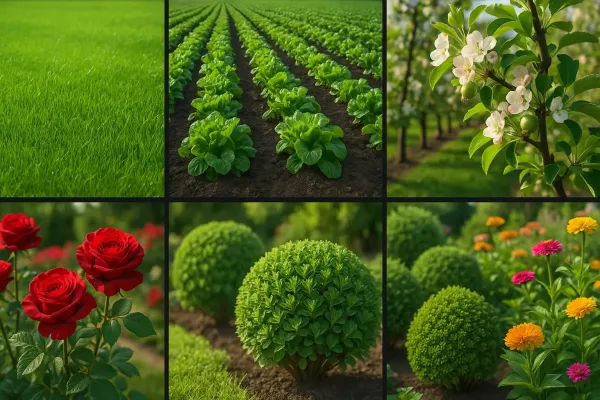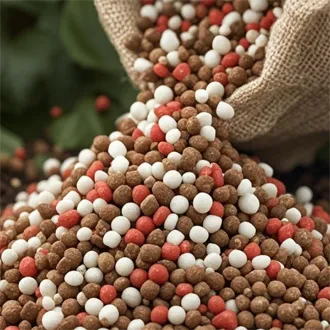Avoid your inquiry is delay response, please enter your WhatsApp/Skype along with the message, so we can contact you at the very first time.
We will reply you within 24 hours. If for urgent case, please add WhatsApp/WeChat:
Warning: Undefined variable $public in /www/wwwroot/lvfertilizer.com/wp-content/themes/hyhadmin/header.php on line 350
Warning: Trying to access array offset on value of type null in /www/wwwroot/lvfertilizer.com/wp-content/themes/hyhadmin/header.php on line 350
,. Or call
Warning: Undefined variable $public in /www/wwwroot/lvfertilizer.com/wp-content/themes/hyhadmin/header.php on line 350
Warning: Trying to access array offset on value of type null in /www/wwwroot/lvfertilizer.com/wp-content/themes/hyhadmin/header.php on line 350
directly.
I see many growers face uneven growth, weak flowering, and slow recovery after stress. A balanced NPK often fixes this fast.
15-15-15 is a general-purpose fertilizer for lawns, vegetables, fruit trees, roses, shrubs, and ornamentals. It works best for maintenance feeding on medium-fertility soils and for rebalancing growth before flowering and fruit set.

You want one blend that fits many crops. I use 15-15-15 when soils test near target levels. I apply it lightly, then I switch to crop- or stage-specific ratios for peak yield and quality.
Tomato plants look hungry when leaves pale, flowers drop, and fruit stays small. A simple blend can help fast.
Yes, 15-15-15 can feed tomatoes in early growth on average soils. I use light, even applications, then I move to higher potassium once flowering starts to protect fruit size, flavor, and firmness.
I grow and supply for many climates. Tomatoes need steady nitrogen for leaves and stems, phosphorus for strong roots and flowers, and potassium for fruit quality and disease tolerance. 15-15-15 offers equal parts of N, P, and K. This balance supports seedlings and vegetative growth on soils that are not poor or extreme. I use it to start plants cleanly when I do not know the soil test or when I see balanced needs in tissue reports.
Then I change the ratio. Once I see first clusters, I reduce nitrogen and increase potassium. I do this because too much nitrogen at bloom makes lush vines and fewer fruits. Potassium pushes sugars, color, and shelf life. I also watch phosphorus. Many soils already hold enough P. If I see purple veins or slow roots, I adjust with a modest P boost rather than a heavy one.
| Stage | Need Focus | 15-15-15 Fit | My Adjustment |
|---|---|---|---|
| Seedling to 4–6 true leaves | Rooting, steady leaf build | Useful at light dose | Keep even feed; avoid excess salts |
| Pre-bloom to first flowers | Transition to generative growth | Limited | Start raising K; watch N |
| Fruit set to harvest | Fruit fill, flavor, firmness | Not ideal alone | Move toward higher K, lower N ratio |
I avoid 15-15-15 in very poor soils or salt-sensitive systems because the equal ratio can still deliver too much salt per unit of phosphorus needed. I split applications, water in well, and I complement with calcium (for blossom-end rot risk) and magnesium if leaf color fades between veins. I always tell partners: soil and water tests first if possible. 15-15-15 is a safe early step, not the finish line for tomatoes.
Many guides give one answer, but tomatoes change needs with each stage.
I use stage-based ratios. Early growth runs near balanced N:P:K. Bloom and fruit fill work better with higher K than N. A simple rule is about 1:1:1 early, then 1:1:2 from flowering to harvest, adjusted by soil tests.
Tomatoes reward simple, steady feeding. In the vegetative stage, an even ratio supports roots and canopy. Once clusters appear, I favor potassium. Potassium drives water movement, stress tolerance, and fruit quality traits like color and brix. Too much nitrogen after flowering makes vines soft and reduces fruit set. Too little nitrogen makes small fruit and early leaf drop. The best ratio is not a fixed number; it is a curve.
| Stage | Typical Ratio Target | What I Watch | Notes |
|---|---|---|---|
| Seedling to pre-bloom | ~1:1:1 | Leaf color, internode length | Keep plants compact; avoid lushness |
| Early bloom to set | ~1:1:1.5 | Flower holding, first set | Slight K bump improves set |
| Bulk fruiting | ~1:1:2 | Fruit size, brix, firmness | Potassium-led feeding shines |
| Late season finish | ~1:0.8:2+ | Leaf aging, disease pressure | Maintain K; trim N to reduce soft growth |
I protect calcium supply at all stages to limit blossom-end rot. I watch EC in fertigation lines. If conductivity spikes, I split feeds into smaller pulses. For soils high in phosphorus, I choose low-P blends and add K through sulfate of potash or nitrate sources, depending on pH goals. My team also uses tissue tests at flowering and mid-harvest to confirm the K:N balance. This keeps fruit uniform and reduces waste.
Growers often ask for one magic ratio for every crop. I understand the need for simple rules.
I match ratios to crop type, growth stage, and soil tests. Balanced blends work for general maintenance. High-K blends suit flowering and fruiting. Low-P blends fit P-rich soils. The “best” ratio is the one your plants can use now.

I start with the crop goal. Leafy greens respond to moderate nitrogen and steady potassium for turgor. Fruit crops want potassium as they set and swell. Root crops accept moderate K and careful P to support early root tips. Soil tests guide the baseline. If phosphorus is high, I avoid equal-ratio blends because they add unneeded P. If potassium tests low, I bring K up fast with a K-led ratio. Water quality matters as well. High bicarbonates push pH up. In that case I pick acidifying sources and control the ratio without pushing salts.
| Scenario | What Soil/Plant Shows | Ratio Direction | Why |
|---|---|---|---|
| Maintenance on medium-fertility soil | Balanced tissue readings | 1:1:1 | Simple upkeep without oversupply |
| Flower and fruit stages | Good canopy; fruit load rising | 1:1:1.5 to 1:1:2 | K supports fill, color, shelf life |
| P already high in soil | Leaf tissue P adequate or high | Low P, higher K | Avoid lockouts and runoff risk |
| Low K, saline risk | Margins scorch, small fruit | K-led, split feeds | Potassium helps stress tolerance |
| Cool early season | Slow roots, purple casts | Slight P emphasis, careful EC | Support roots without salt shock |
I also think about delivery method. For drip systems, water-soluble blends let me micro-dose. For broadcast on field crops, I choose granules with steady release. When growers do not have tests, I begin with a balanced feed at low rate, then I observe response in seven to ten days. I adjust toward more K or less N based on leaf color, node spacing, and first flower behavior. Simple steps keep costs down and protect soil health.
Roses reward steady care. They punish big swings in nutrients and salts.
15-15-15 works for established roses on average soils if I apply lightly and often. I switch to a slightly higher K ratio before peak bloom to support petals, color, and vase life.

I manage rose feeding like I manage fruit crops. I build the base with a balanced blend in spring when canes push. This supports new leaves and root repair after pruning. Then I reduce nitrogen and lift potassium before heavy bloom cycles. I do this to support thick petals and strong stems. Excess nitrogen gives lush leaves and weak stems. It also invites pests. I avoid heavy single doses. I split feeding to prevent salt stress on fine feeder roots.
| Phase | Focus | 15-15-15 Role | Adjustment |
|---|---|---|---|
| Spring push | Leaf and root rebuild | Light, balanced feed | Add magnesium if leaf green is dull |
| Bud set | Petal and stem strength | Limited | Raise K; keep N moderate |
| Peak bloom | Color, fragrance, vase life | Not ideal alone | K-led blends; add micronutrients |
| Hot stress | Leaf edge burn risk | Very limited | Foliar micro feed; careful EC |
I also guard micronutrients. Roses show iron chlorosis in high pH soils. I add chelated iron and sometimes manganese. I keep sulfur in mind to nudge pH down in calcareous soils. Mulch helps moisture and root health, which lets the plant use the fertilizer you buy. For containers, I avoid strong equal-ratio granules because salts build up fast. I prefer controlled-release prills or dilute soluble feeds with good leaching. This simple program gives fuller blooms and fewer losses.
15-15-15 is a smart starting point on average soils. I begin balanced, then I adjust to crop stages and soil tests for better yield and quality.